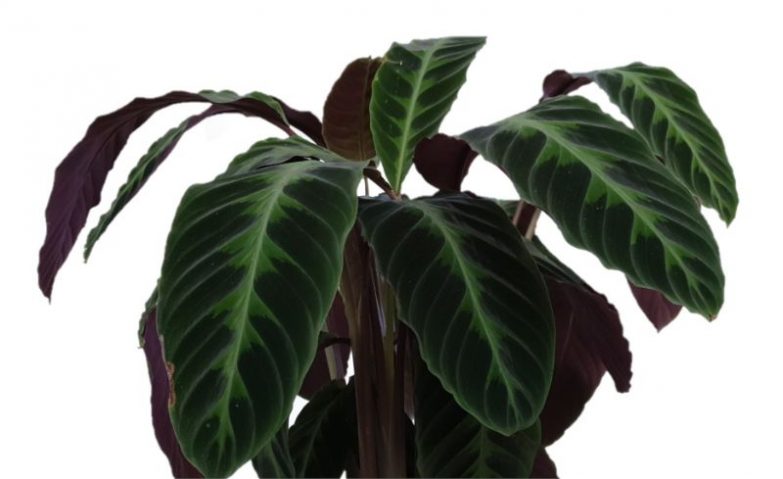Calatheas are stunning tropical plants with brilliantly patterned leaves. Calathea warscewiczii is one of the most remarkable varieties, sporting exotic velvety foliage with two-toned green tops and burgundy-colored undersides. Pronunciation of its name isn’t the only difficult thing about the Warscewiczii – they are Calatheas, after all – but I’ll show you how to keep them happy and looking their amazing best.
Summary of Calathea Warscewiczii Care: Warscewiczii likes consistently moist, well-draining soil, and bright-to-medium indirect light. Humidity of over 50% keeps the plant looking its best. Give them warm temps year round and feed lightly through the growing season. They don’t like being disturbed and prefer infrequent repotting.
Overview Of Calathea Warscewiczii
Calathea warscewiczii (commonly pronounced vark-zeh-wik-ZEE-eye) was recently renamed Goeppertia warszewiczii for taxonomic reasons, but the change hasn’t become ubiquitous yet. Also known unofficially as Calathea Jungle Velvet, this perennial evergreen is a member of the Prayer Plant family (Marantaceae) and hails from Central and South America.
Mature Warscewicziis are large houseplants that can grow to 3-4 feet high and wide in optimal conditions. Its soft velvety leaves feature a striking light-and-dark green fishtail pattern with solid purplish tones underneath. The plant may bear small cream-colored flower cones in season.
The Warscewiczii originates from tropical forest undergrowth. Its active leaves move by nyctinasty in response to temperature and light. The foliage isn’t quite as dramatic in their movements as their cousin Prayer Plant, but they do perform a slow daily dance and rise at night. If the plant seems different every time you look, it’s probably not just you.
The Calathea family has an unfortunately well-deserved reputation for being temperamental, but it’s really because our home conditions are so different than their natural habitat. If you lived in a greenhouse with average highs of 90ºF and 90% humidity, the plant would be easy to care for.
A Warscewiczii needs bright indirect light, warm temperatures and consistent soil moisture – unfortunately, caregiving mistakes show up in their leaves. If you correct their conditions, they can recover without a grudge and produce new leaves just as beautiful as before.
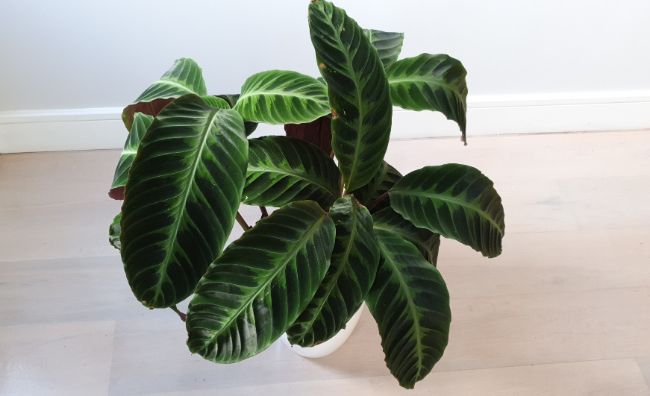
Calathea Warscewiczii Care Summary
| Scientific Name | Calathea warscewiczii (Now officially Goeppertia warszewiczii) |
| Common Name | Calathea Jungle Velvet |
| Origin | Central And South America |
| Light Requirements | Medium, filtered light |
| Watering | Maintain moist soil with regular watering, but do not let the soil become soggy. Use filtered, distilled or rainwater ideally. |
| Soil | Well draining potting mix. A good mix is two parts peat/coir and one part perlite. |
| Temperature | 65-85ºF (18-29ºC). Intolerant to colder temperatures and drafts. |
| Fertilizer | Monthly while actively growing with 1/4-1/2 strength, balanced fertilizer. Flush the soil several times per year. |
| Humidity | High humidity is essential. >50% is the minimum to keep foliage healthy. |
| Flowering | Cream-colored, cone-shaped flowers emerge from a central stalk. Doesn’t ofter flower indoors. |
| Pruning | Minimal pruning requirements. Prune old or yellowed leaves. |
| Propagation | Propagate by division in spring or early summer. |
| Re-Potting | Only repot once root bound, and do so carefully, as doesn’t like to be disturbed. |
| Diseases And Pests | Prone to mealybugs, mites, and scale. Overwatering can cause diseases such as fusarium, leaf spot and pseudomonas. |
| Toxicity | Non-toxic to humans and animals. |
| Where To Buy | Buy Calathea warscewiczii online at Etsy (I buy most of my houseplants from Etsy). |
Light Requirements
Calathea warscewiczii needs medium to bright, indirect light. The leaves scorch quickly in direct, intense sunlight. The further north you are, the more partial sun it can tolerate.
A western exposure with protection from hot afternoon rays is ideal, but the plant can also do well in an east- or north-facing window. Direct lighting from a southern exposure may also work if the pot is placed a few feet from the window or protected with sheer curtains.
On the lesser side of light, a Warscewiczii can prosper as long as it receives more than needed to easily read by. Note that too much illumination without sufficient humidity can cause browning on the leaves.
Watering Balance
Your Calathea warscewiczii needs consistently moist soil that never becomes sodden or too dry. Their leaves are too busy adjusting to light variations to be dependable signals of when they need water. You can’t use a predetermined schedule, either: you have to monitor them regularly. Calatheas aren’t called high maintenance for nothing.
A moisture meter can be handy for large, well-filled containers, but their readings may vary according to the soil type … using a finger to check the topsoil is a simple and dependable method.
During the warm growing season, keep the soil moist by watering when the top half-inch of soil dries out. Be sure the pot has adequate drainage, and water thoroughly. Let some excess flow through the holes to flush the medium.
Tips to keep in mind:
- Use room-temperature water to avoid unnecessary stress.
- Water early in the day so the plant dries before nightfall: a plant that stays wet overnight is asking for fungal issues.
- Your Warscewiczii is super-sensitive to salts and other toxic impurities. Filtered dechlorinated water is often adequate, but some growers use distilled water or rainwater to be completely safe.
- Keep the soil drier during the winter, but don’t let it completely dry out. You don’t want them sitting in very wet soil during dormancy.
- Some growers use self-watering devices to keep the soil moist, but make sure they are working properly and continue to regularly monitor the soil. Wet soil promotes pests, diseases—and worst of all, root rot.
- Letting extra water exit the drainage holes every watering session helps cleanse the mix. It’s good to thoroughly flush it every couple of months: put the pot in a place it can drain freely, and water thoroughly until the soil is well rinsed.
For more information on how to give your houseplants just the right amount of water to keep them thriving, read this article.
The Right Soil
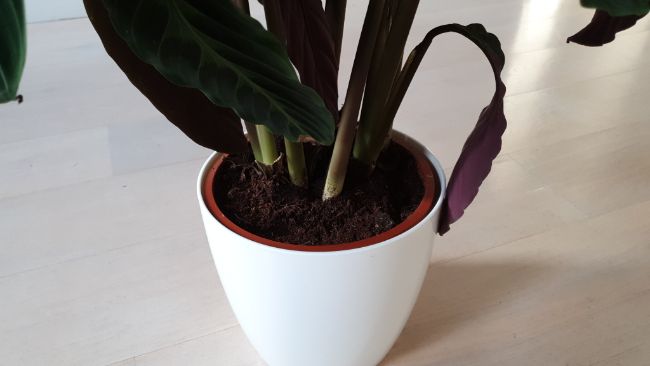
The composition of your soil is critical for a Warscewiczii. The medium needs to hold sufficient water for their roots to stay moist, but also have enough structure and aeration to preserve soil oxygen and never become soggy.
Perlite, pumice, coarse sand, or other inert aeration materials are adequate, but they don’t hold water as well as peat or coco coir. A mix of one part perlite and two parts peat or coir is a good soil recipe.
You can add other organic amendments for additional fertility, but be aware these decompose over time. Peat breaks down, too. This degradation causes the mix to compact and lose aeration capacity over time, so the medium will need to be replenished after a few seasons. Read more about how to choose or make perfect houseplant soil here.
Warm Temperature
Calathea warscewiczii does well in our temperatures indoors, but they definitely enjoy the warmer end of the spectrum. During the growing season they prefer 65-85ºF (18-29ºC) and can tolerate 90ºF (32ºC) or above with sufficient humidity.
The plant naturally approaches dormancy when the temperatures drop to the mid-60s (ºF). It doesn’t thrive in colder conditions … the leaves can be damaged if the plant gets even a brief chill. As a tender tropical, it doesn’t appreciate drafts or sudden temperature changes, either.
If you summer the plant outdoors, take them in well before cooler overnight temperatures arrive.
Light Fertilizer
Calatheas don’t need heavy fertilization, so err on the side of restraint. Feeding once a month during the growing season is enough.
Use a balanced fertilizer or possibly one with a bit more nitrogen and phosphorus than potassium. Dilute to 1/4 to 1/2 the recommended dose.
An organic fertilizer is less likely to damage the sensitive roots through an overdose, and it leaves less residual elements in the soil. If you prefer using synthetics, a mild application of slow-release fertilizer can be a good option. This article covers everything you need to know about fertilizing your houseplants.
High Humidity
One reason Calathea warscewiczii is considered a fussy plant is that it needs higher humidity than the average home offers. They can adapt to less than the moist air of their native jungle, but they become more temperamental as the humidity goes down.
To keep your Warscewiczii looking its best, try to maintain 50% or higher humidity. A low-cost hygrometer can help you maintain the right level.
You can raise humidity in several ways:
- Keeping the plant in a bright bathroom can give it the benefit of steamy showers.
- Grouping plants so they can benefit from each other’s transpiration. Give them space, though, both for air circulation and to cut down on pest and disease transmission.
- A low-maintenance, low-tech method is to use a water tray filled with pebbles and placing the plant’s container over it. Make sure the soil isn’t touching the water. The evaporation helps raise humidity a few percentage points—it’s not dramatic, but it can help.
- Though labor-intensive, a room humidifier is the ultimate solution.
- Though often recommended, misting probably isn’t a big help: it doesn’t last long enough to make a real difference in humidity, and wetting the leaves regularly can open the door to disease. If you do give your Warscewiczii an occasional spritz, use distilled water to avoid leaf spotting.
Read my article about increasing humidity for your houseplants to learn more.
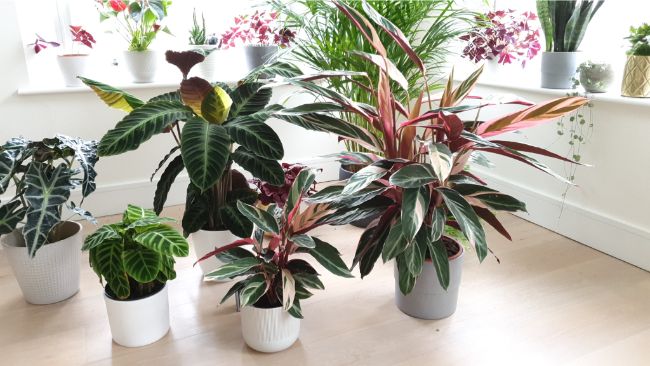
Flowering
Calatheas aren’t grown for their flowers, but the Warscewiczii can produce a cream-colored, cone-shaped floral display as a side attraction. They don’t regularly bloom indoors, but a happy plant may surprise you. The bud emerges on a central stalk and gradually fades to a yellow shade tinged with pink.
Pruning
You can’t train a Warscewiczii like a topiary shrub, but you can shape its look by removing old or damaged leaves. Pruning can stimulate new foliage, too. Use sharp, sterilized shears and cut the base of the leaf where it meets the stalk.
Propagation
Though Calatheas produce seeds, the most common way to propagate Calathea warscewiczii is by division of their rhizome. It does pose a risk, however – the plant doesn’t like having their roots disturbed. Wait until a spring repotting and be as gentle as possible.
Rhizome Division
1. If your Warscewiczii has overgrown its pot, you can pull individual divisions apart. Unpot the plant and tease the roots into sections with at least one leaf each.
2. Alternatively, divide the plant’s rhizome with a sterile cutting tool. Make sure each section has roots and at least one leaf.
3. Plant each section in a smaller container. Use the same soil as the mother plant.
4. Water the plantlets; envelop the planting container in plastic to increase its local humidity and preserve soil moisture.
5. Keep the cuttings in bright light away from direct sun. Keep them warm; mist occasionally but don’t overwater.
6. You should see signs of growth in a few weeks. At that point, remove the plastic covering and begin normal care.
Stem Cuttings
Because there isn’t a stem node to grow roots from, it’s difficult to grow a Calathea warscewiczii from a cutting. It’s less invasive for the plant, however, so you might want to give it a try.
Here are the steps:
1. Take four-to-six inch cuttings, each with three or four leaves attached.
2. Place the cuttings in a 50-50 mix of peat and sand. Water lightly and place under clear plastic to form a humidity tent.
3. Keep the cutting warm in bright but gentle indirect light. Repot once it forms a small root system and give it normal care.
For a complete guide to propagating houseplants, read this article.
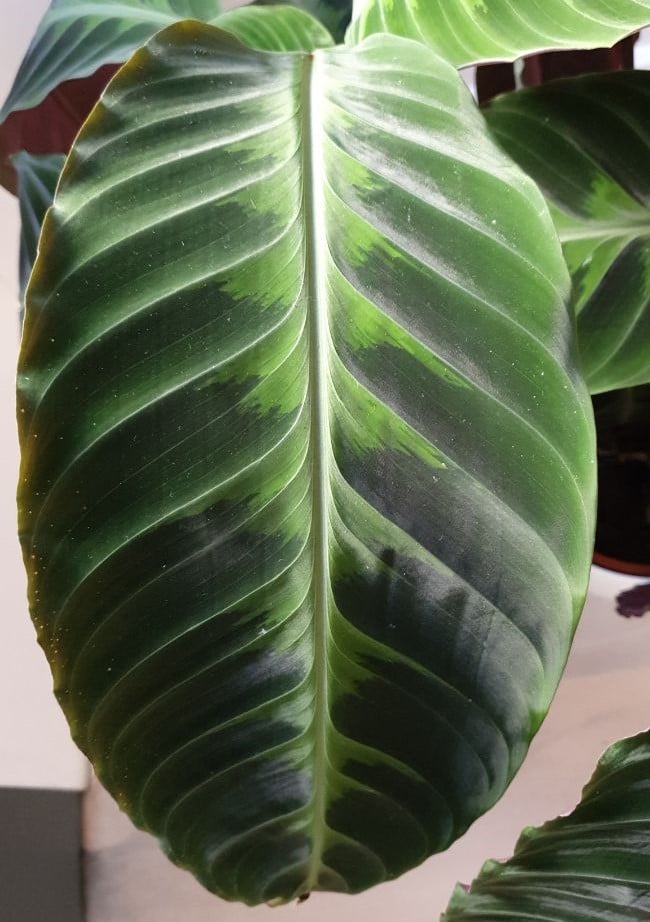
Tips For Planting
- Don’t panic if your Warscewiczii develops minor imperfections. Small leaf blemishes are normal, and older leaves discolor and drop off.
- Trim unsightly leaves. They don’t recover, and minor pruning doesn’t hurt the plant.
- Most Calathea problems come from overwatering, but they can suffer from underwatering, too. Very dry soil may actually repel water, so soak the medium thoroughly if you’ve accidentally given your Warscewiczii a dry spell. Note that peat is harder than most amendments to re-moisten.
- Let the plant rest quietly in a suitable spot once you get it home. Don’t prune heavily, fertilize, or repot until it’s had a chance to acclimate.
- Unless there’s a serious problem, don’t be in a hurry to repot or change the soil of a new plant. If you don’t like the nursery pot’s appearance, put it inside a decorative container to hide it.
- Don’t try to fertilize or water your way out of a problem. The best practice is to review the plant’s treatment and correct it going forward.
Gentle Repotting
Repotting is such a common horticultural practice that it’s easy to overlook how disruptive it is. We humans tend to like new surroundings … plants don’t necessarily share that enthusiasm.
Calathea warscewiczii doesn’t typically need to be repotted more than every two years. Here are signs your plant may need new digs:
- Slower growth.
- It needs to be watered more than twice a week.
- The foliage seems oversized compared to the pot.
If you suspect the plant is ready for new quarters, check the root system. If the soil has largely been replaced by roots and some are circling the bottom, it’s time.
Only pot up one size. The empty soil of an overly spacious container doesn’t contain enough roots to absorb moisture, making it easy to overwater.
Repot in the spring to give the plant time to relaunch. Try to be gentle with the roots and don’t tamp the new soil down too hard; water to settle the medium.
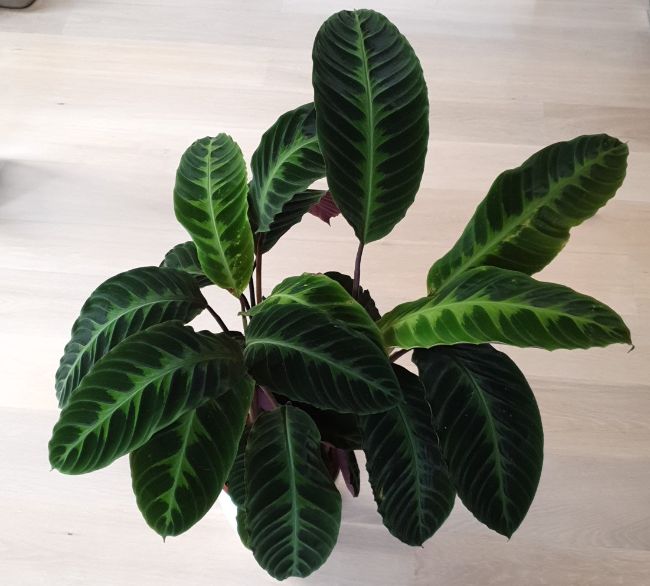
Varieties
There are dozens of Calathea varieties with beautiful foliage, but there’s only one variety of Warscewiczii. It would seem hard to improve.
Diseases And Pests
The Warscewiczii’s typical pests include mealybugs, mites, and scale. They cause leaf damage and stunting, so regularly inspect the stems and undersides of the leaves to catch problems early.
Mealybugs – Look for white, cottony masses nestled underneath leaves and on stems. They can infest the roots, too. Stickiness and mold from their honeydew is a sign of their presence.
Mites – These tiny critters are often overlooked until the plant shows leaf yellowing or speckling. Their detritus and tiny webs are easily mistaken for dust. Tarsonemid mites cause what appear to be water-filled lesions on the foliage.
Scale – These legless insects come in many colors and can be hard to spot. They typically look like bumps. They also excrete sticky honeydew that results in sooty mold.
You can kill these pests individually with Isopropyl alcohol, but larger colonies are best treated with horticultural oils and insecticidal soap. Coat the plant thoroughly and repeat as necessary. A severe infestation responds to systemic pesticides, but it’s best to flush the soil afterwards to avoid residual toxicity.
Read my article about identifying, treating and preventing common houseplant pests to learn more.
The takeaway for Warscewiczii’s most common diseases is to avoid overwatering and don’t let water sit on leaves:
Leaf Spot – there are several diseases called Leaf Spot. Alternaria and Helminthosporium fungal infections are less serious and cause small lesions that are best treated by reducing moisture levels and keeping the leaves dry.
Pseudomonas – This type of Leaf Spot causes dark green or black lesions up to an inch wide. It thrives in moist conditions and is highly contagious. Copper bactericides are the only treatment for Pseudomonas but they’re rather ineffective: the recommendation is to safely destroy the plant.
Fusarium – This common Calathea affliction is a soil-borne fungus that primarily causes yellowing and wilting of seedlings and cuttings. Copper fungicides provide limited relief, but the most effective treatment is to wash the roots clean of infected soil and replant in fresh, uncontaminated media.
Cucumber mosaic virus (CMV) – This virus causes minor symptoms on Calatheas, but it can be spread to other plants that aren’t resistant. It shows up as bright yellow jagged streaks on the leaves. Safely disposing of infected plant parts is the only solution.
Toxicity
The wonderful Warsewiczii is non-toxic to cats, dogs, horses … and people, too.
Common Problems And Questions
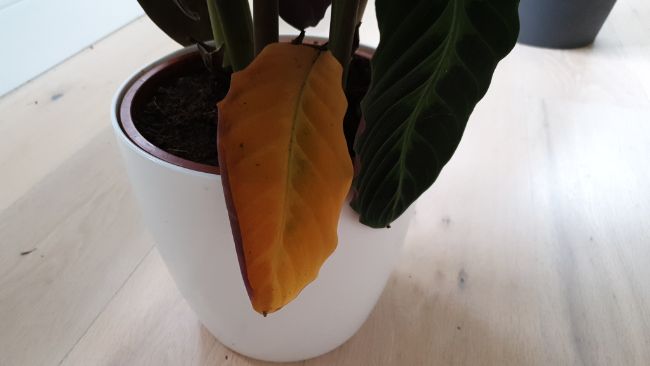
Why Are My Calathea Warscewiczii Leaves Curling?
Cool temperatures can cause curled leaves, but lack of moisture and humidity are the most common cause for curled leaves. Growers can be so afraid of root rot – deservedly so – that we chronically underwater. Thoroughly soak and drain the pot when you water to ensure the soil is evenly drenched. Read my article about the causes of curling calathea leaves and how to fix it for more info.
Why Are My Calathea Warscewiczii Leaves Turning Yellow?
The most common reason is overwatering, which will cause generalized yellowing of the leaves. However, acclimatization to your home may cause yellowing of some leaves, as can many other reasons related to suboptimal growing conditions. Temperature, humidity, soil, watering, fertilizer, pest and disease problems can all cause yellow leaves on your Calathea warscewiczii. It may take a little detective work to determine the cause, but this article will help you identify the cause and fix yellow leaves on any of your calatheas.
When Should I Repot My New Calathea Warscewiczii?
Unless the potting soil is extremely unsuitable, there’s usually no hurry to repot. It takes Calatheas time to get comfortable in new surroundings, and meanwhile they can deal with being a little rootbound. Waiting until spring is usually a good practice. Read this article for step by step instructions for repotting.
My Warscewiczii’s Leaves Started Drooping After I Bought It…
Low-angled leaves don’t always mean a problem. It’s possible that they are drooping from underwatering or age, but they’re often simply orientating to different light. Greenhouses and outdoor nurseries usually have overhead illumination, while most houseplants receive get light from windows or another lateral source.

